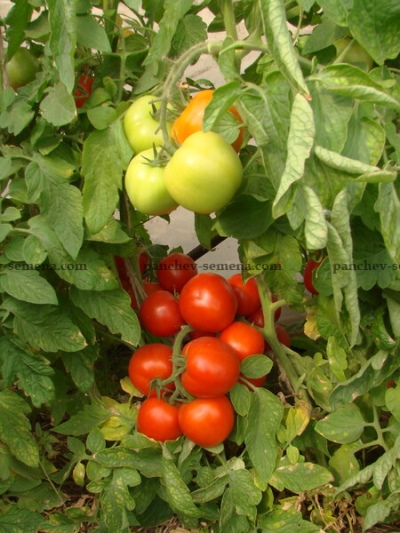
- Name synonyms: Bulat F1
- Category: hybrid
- Growth type: determinant
- Appointment: universal
- Ripening period: ultra early
- Ripening time, days: 79-85
- Growing conditions: for open ground, for film greenhouses
- Transportability: high
- Marketable fruit yield,%: 93
- Bush size: undersized
Tomato Bulat is one of the most attractive modern varieties. The possibilities for its cultivation are quite large. But the more relevant is the study of the specific nuances and subtleties of this plant.
Description of the variety
Bulat is a hybrid determinant variety. The crop is suitable both for open cultivation and for planting in greenhouses. The bushes are not tall. A moderately high number of leaves is characteristic. Experts note the decent marketability of Bulat.
The main qualities of the fruit
They are characterized by:
dense red color of ripe tomatoes;
weight from 110 to 200 g;
predominantly round shape;
5 or 6 fruits per cluster;
excellent pulp density;
decent skin density.
Taste characteristics
Tomato Bulat is notable for its sweetness. Excellent aroma is typical for it. The pulp is very juicy and pleasant to consumers.
Ripening and fruiting
This variety belongs to the ultra-early group. It will ripen in about 82 (on average) days. Therefore, it can be grown in a wide variety of conditions, including relatively cold climates. The berries will appear for a very long time, which pleases any gardener.
Yield
Among the total harvest, up to 93% of the fruits are highly marketable. In the first 2 seasons, the collection will be 5.2 kg per 1 m2. At the end of the usual period, it reaches 12 and even 14 kg. It is stated that the potential fertility can be 15-16 kg. However, it is only achieved with a very careful approach and is hardly achievable in a conventional gardening business.
The timing of planting seedlings and planting in the ground
It is impossible to do without seedlings when growing this crop. The seeds must first be kept in potassium permanganate. Sowing is done at the end of February or in the first decade of March. It is necessary to keep the sown at a temperature of 24 degrees until shoots form. When these seedlings stand for 50 days, they can be transplanted into open ground.
Additionally recommended:
processing of seedlings with warm water through a spray bottle;
hardening for 6-7 days (when it is kept at a temperature of 14-15 degrees);
double feeding with "Krepysh" preparation;
dive after the release of the 2nd true leaf.

Growing tomato seedlings is an extremely important process, because it largely depends on whether the gardener will be able to harvest at all. All aspects must be taken into account, from seedbed preparation to planting in the ground.
Landing scheme
The depth of the furrows is 1.5 cm. The distance between individual seeds is 3 cm. A typical scheme for planting seedlings in open ground is 700x400 mm. Moreover, for 1 sq. m there may be 3 or 4 bushes. After formation, 1 stem is left per bush.

Growing and care
Bulat steadily transfers contact with:
alternaria;
tobacco mosaic;
fusarium wilting.
Most of the abrupt weather changes are also not dangerous for him.Although it is hardly worth abusing such a circumstance. Damask steel should be watered, like other tomatoes, with warm water, abundantly. To replenish the loss of nutrients, mineral fertilizers of a complex composition are recommended. You will have to loosen the soil and weed it regularly from the weeds.
Procedures such as are strictly required:
garter;
pinching;
formation.
It is necessary to pick up such tomatoes up to the 1st brush. Important: when transplanting into open land, you should make sure in advance that the danger of frost has completely disappeared. Bulat needs support throughout the entire time of his development. Mulching is allowed. And also noted the potential for cultivating this tomato on a trellis.
Heavy soils are not particularly scary for Bulat. However, at the same time, he absolutely cannot stand shading. This is an extremely light-loving culture. In addition to mineral mixtures, you can fertilize it with mullein and bird droppings. But these components are rather auxiliary in nature; the same can be said about drugs that stimulate plant growth.




A plant needs different micronutrients at each stage of growth. All fertilizers can be divided into two groups: mineral and organic. Folk remedies are often used: iodine, yeast, bird droppings, eggshells.
It is important to observe the rate and period of feeding. This also applies to folk remedies and organic fertilizers.



























































































